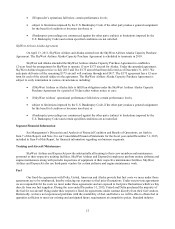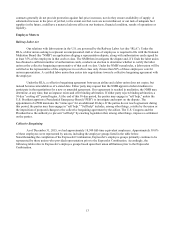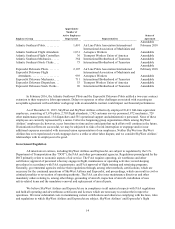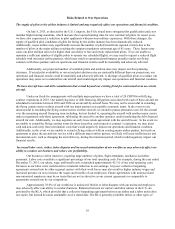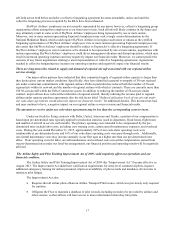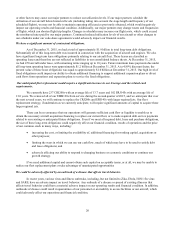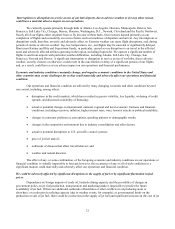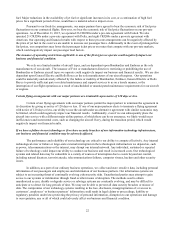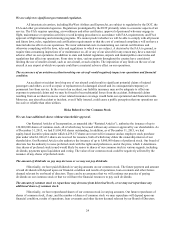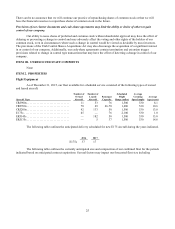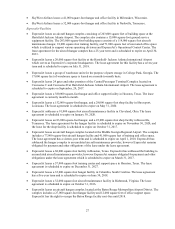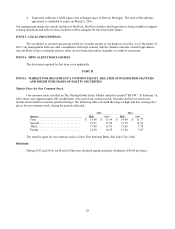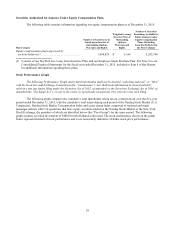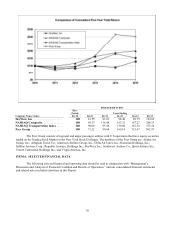SkyWest Airlines 2015 Annual Report Download - page 24
Download and view the complete annual report
Please find page 24 of the 2015 SkyWest Airlines annual report below. You can navigate through the pages in the report by either clicking on the pages listed below, or by using the keyword search tool below to find specific information within the annual report.20
or other factors may cause our major partners to reduce our utilization levels. If our major partners schedule the
utilization of our aircraft below historical levels (including taking into account the stage length and frequency of our
scheduled flights), we may not be able to maintain operating efficiencies previously obtained, which would negatively
impact our operating results and financial condition. Additionally, our major partners may change routes and frequencies
of flights, which can shorten flight trip lengths. Changes in schedules may increase our flight costs, which could exceed
the reimbursed rates paid by our major partners. Continued reduced utilization levels of our aircraft or other changes to
our schedules under our code-share agreements would adversely impact our financial results.
We have a significant amount of contractual obligations.
As of December 31, 2015, we had a total of approximately $1.9 billion in total long-term debt obligations.
Substantially all of this long-term debt was incurred in connection with the acquisition of aircraft and engines. We also
have significant long-term lease obligations primarily relating to our aircraft fleet. These leases are classified as
operating leases and therefore are not reflected as liabilities in our consolidated balance sheets. At December 31, 2015,
we had 470 aircraft under lease, with remaining terms ranging up to 10 years. Future minimum lease payments due under
all long-term operating leases were approximately $1.2 billion at December 31, 2015. At a 4.89% discount factor, the
present value of these lease obligations was equal to approximately $1.0 billion at December 31, 2015. Our high level of
fixed obligations could impact our ability to obtain additional financing to support additional expansion plans or divert
cash flows from operations and expansion plans to service the fixed obligations.
Our anticipated fleet replacement would require a significant increase in our leverage and the related cash
requirements.
We currently have 237 CRJ200s with an average life of 13.7 years and 182 ERJ145s with an average life of
13.0 years. We removed all of our EMB120s from service during the second quarter of 2015, and we anticipate that over
the next several years, we will continue to replace the CRJ200s and ERJ145s with larger regional jets. Our fleet
replacement strategy, if undertaken as we currently anticipate, will require significant amounts of capital to acquire these
larger regional jets.
There can be no assurance that our operations will generate sufficient cash flow or liquidity to enable us to
obtain the necessary aircraft acquisition financing to replace our current fleet, or to make required debt service payments
related to our existing or anticipated future obligations. Even if we meet all required debt, lease and purchase obligations,
the size of these long-term obligations could negatively affect our financial condition, results of operations and the price
of our common stock in many ways, including:
• increasing the cost, or limiting the availability of, additional financing for working capital, acquisitions or
other purposes;
• limiting the ways in which we can use our cash flow, much of which may have to be used to satisfy debt
and lease obligations; and
• adversely affecting our ability to respond to changing business or economic conditions or continue our
growth strategy.
If we need additional capital and cannot obtain such capital on acceptable terms, or at all, we may be unable to
realize our fleet replacement plans or take advantage of unanticipated opportunities
We could be adversely affected by an outbreak of a disease that affects travel behavior.
In recent years, various virus and illness outbreaks, including, but not limited to Zika, Ebola, H1N1 flu virus
and SARS, have an adverse impact on travel behavior. Any outbreak of a disease or spread of existing illnesses that
affects travel behavior could have a material adverse impact on our operating results and financial condition. In addition,
outbreaks of disease could result in quarantines of our personnel or an inability to access facilities or our aircraft, which
could adversely affect our operations and financial condition.




